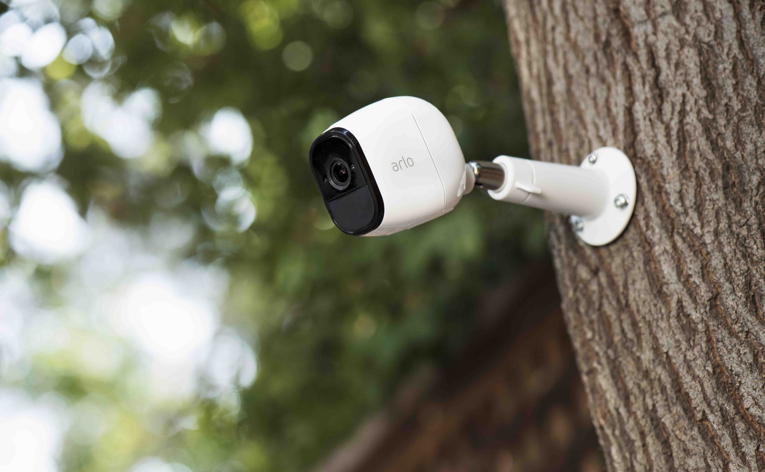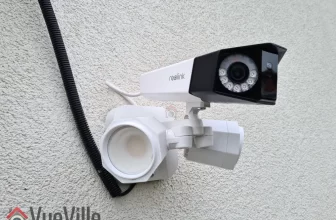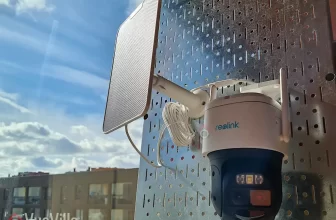
Netgear has now released an updated version of the Arlo Pro, the Arlo Pro 2. Is it worth paying a bit more to get the new model, or will the older model suffice?
We strongly recommend the Arlo Pro 2 over the Arlo Pro because it has:
- higher 1080p resolution,
- more accurate PIR based motion detection and
- pre-recording for zero-lag motion triggered recording.
Read on for an in-depth comparison of these two high-end Arlo models.
A quick note: As an Amazon Associate I earn from qualifying purchases. This post contains affiliate link(s). An affiliate link means I may earn advertising or referral fees if you make a purchase through my link, at no extra cost to you.
The Arlo Wire-free
Often the most visible elements of a smart home, security cameras are also one of the most difficult to choose and set up. For the longest time, security cameras were not considered mainstream enough by large consumer electronics companies. Very capable cameras were available but setting them up proved too daunting a task for many a DIY amateur.
The Netgear Arlo changed all that. Netgear shook up the home security world with the battery powered 720p Arlo wire-free or as Netgear now calls it, just Arlo. It was soon followed up with the Arlo Pro which had 2-way audio support and optional AC power. The Arlo range of cameras are not standalone devices, they require the base station to function. The Arlo Q family does not need the base station and will connect directly to your router.
We are not the biggest fans of using only battery powered cameras, but as part of a well-planned security camera strategy, battery powered cameras can be invaluable.
Arlo Pro 2 vs. Arlo Pro – Comparison Table
| Feature | Arlo Pro 2 | Arlo Pro |
|---|---|---|
| Resolution / Video Format | 1080p HD (1920 x 1080) / H.264 | 720p HD (1280 x 720) / H.264 |
| Motion Detection on battery | PIR sensor, 23 feet range | Software-based simple detection |
| Motion Detection plugged in | Software based, up to 3 zones | Software-based simple detection |
| Pre-recording (3 second lookback) | Yes | No |
| Base station needed for camera to work | Yes | |
| Power source | AC Power / Rechargeable battery (VMA4400) | |
| Audio support | 2-way audio with speaker and microphone | |
| Imaging | Full color CMOS Auto-adaptive white/black balance and exposure | |
| Angle of view | 130° | |
| Wi-Fi | 2.4GHz 802.11n, up to 300 feet range | |
| Night Vision | Yes 850 nm LEDs with 25 feet range IR cut-off filter | |
| Geo-fencing | Yes | |
| Email alerts and push notifications | Yes | |
| Alerts | Motion + Audio detection | |
| Smart Siren | Yes, in base station | |
| Record 24/7 | Yes with paid subscription, only when plugged into AC power | |
| Power adaptor cable model | VMA4700 | |
| Local Storage | Yes, USB drive can be connected to the base station | |
| Smart home compatibility | IFTTT, Alexa | |
| Operating temperature | -4° to 113° F (-20° C to 45° C) | |
| Weather-proofing | IP65 | |
| Dimensions | 79.3 x 48.6 x 70.5 mm, 136g | |
| Datasheet Link | View datasheet | View datasheet |
Video quality
This is perhaps the biggest difference between the two. The new Pro 2 model has a Full HD 1080p sensor that is significantly better than the 720p sensor of the Arlo Pro. This alone is reason enough in my mind to go for the Arlo Pro 2 instead of the Pro.
The encoding format is the same for both, H.264 instead of the newer and more efficient H.265 that you tend to find in cameras such as the newer models from Dahua and Hikvision.
Both cameras also feature auto-adaptive white/black balance and exposure adjustment.
Audio Quality

Both models support 2-way audio with a built-in mic and speaker. But here’s the rub: they are half-duplex only, meaning they are like walkie-talkies. Only one person is allowed to speak at a time, so you cannot carry on a conversation using these cameras.
Netgear does advertise the 2-way audio as push-to-talk, so at least they are not trying to hide this fact.
The lack of 2-way audio is disappointing because its such a great feature. The battery-powered Reolink Argus has it, albeit slightly laggy. So does the AC powered Reolink C1 Pro, again a bit laggy though.
Step up to the more expensive cameras such as the Vivotek IP8160 & Vivotek IP8160-W if you want to get true high-quality full-duplex audio.
Motion Detection

There are two kinds of motion detection: true motion detection using an Infrared sensor called a PIR (Passive InfraRed), and software based motion detection that analyses video frames to detect changes in the scene.
The first type, PIR-based, is highly accurate indoors, and the second one, software-based, is reasonably accurate indoors. But there is a measurable difference in accuracy between the two.
This is because the software running on the camera cannot distinguish between moving shadows and a moving person, they are both effectively the same to the camera. This is why you get more false alerts with software-based motion detection than the PIR method.
The Arlo Pro uses software-based motion detection whereas the Arlo Pro 2 has a new motion detection system that’s quite clever. In battery mode, it uses the PIR for detecting motion.
In AC power mode, it uses software based motion detection but you can mark up to 3 separate zones for it to monitor. This makes the motion detection capabilities of the Arlo Pro 2 more powerful.
But the main reason we prefer the Arlo Pro 2 is its 3-second lookback feature, which is a fancy marketing term for pre-recording.
Pre-recording is the feature whereby the camera is constantly recording what it sees and keeps the last few seconds in memory. This means there is virtually no lag between the camera detecting motion and the beginning of the recorded clip. This feature also overcomes the biggest complaint with Arlo cameras – the huge lag between motion and the camera starting to record.
The new Arlo Smart subscription adds the hottest feature right now, person detection. But the issue is that the actual person detection is performed not locally by the camera, but remotely in the cloud.
Notifications
Both Arlos are able to send email alerts with snapshots and push notifications based on motion or audio detection.
Weatherproofing
Both Arlo Pro 2 and the Arlo Pro have the same IP65 rating for water-proofing and dust ingress.
Battery-life
Both Arlos use the same VMA4400 rechargeable battery which has a healthy 2440 mAh rating.
Smart Home Compatibility
All Arlos support IFTTT and while this is not the best platform for smart home inter-connectivity, it is better than nothing.
Learn more about security camera and smart home integration here.
The VueVille Verdict
The Arlo family of cameras are cloud-reliant, Internet-reliant security cameras that need a monthly subscription to work as proper security cameras with 24/7 recording on AC power. Even though they support IFTTT for smart home integration, the lack of local storage and cloud-reliance place them well outside of the VueVille Smart Home DIY Framework and are thus not recommended by us.
If you must have an Arlo, the Arlo Pro 2 is far better than the Arlo Pro. The improved image sensor is the primary difference between the two models and is worth paying the extra for.
Alternatives
We reviewed the Reolink Argus wirefree camera and were impressed with its slick setup, 1080p sensor, 2-way full duplex audio, lack of cloud reliance, and local microSD card storage.
Also consider the newer Argus 2 which adds color night vision (Starlight) and a rechargeable battery pack. Since these are purely battery powered cameras, they do not support any smart home integration such as Z-Wave smart hubs, IFTTT, Alexa, SmartThings etc. But at least they are not cloud-reliant.






I believe that the Arlo cameras have been updated with person recognition, wich should improve the software/smart detection falsh positives. What do you think, does this make the Arlo 2 Pro more interesting?
Actuall I’m trying to find a Smart outside survaliance to send out motion alarms based on persons entering into pre setup zones. Should be POE Cam that will work with homeseer HS3 and some sort of NAS NVR.
Any advise on that?
Yes the Arlo Smart subscription adds person detection for a fee. The Arlo Pro is the only one that can record locally without an Internet connection but there is no indication that Arlo Smart will work without the Internet. That’s the question – is the person detection algorithm performed locally or on the cloud? I feel its the latter.
Sticking with the VueVille ethos (local data storage and local processing and smart home compatibility), for a camera that works with Homeseer HS3 and a NAS, I would use a Dahua and this method.